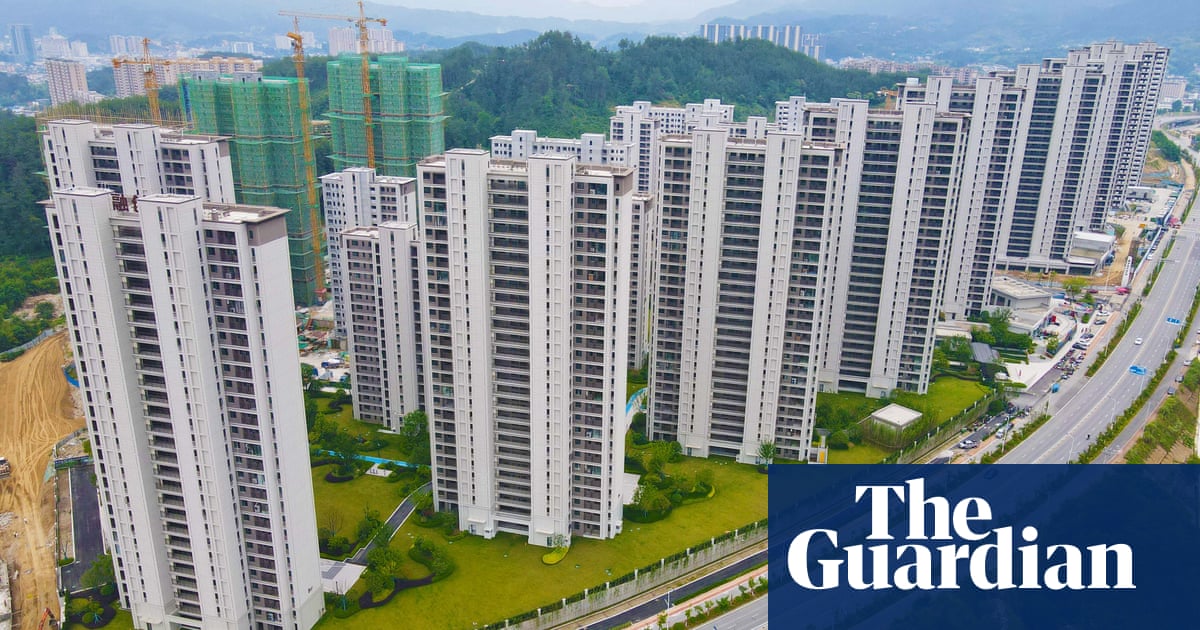- cross-posted to:
- worldnewsnonus@lemy.lol
- cross-posted to:
- worldnewsnonus@lemy.lol
The industry that has traditionally powered about a quarter of GDP has been in a downward spiral that policymakers have struggled to halt
All across China, from Beijing in the north, to Shenzhen in the south, millions of newly built homes stand empty and unwanted. There were nearly 391m sq metres of unsold residential property in China as of April, according to the National Bureau of Statistics. That is the equivalent of Manchester and Birmingham combined – and then some – sitting as vacant, unwanted property.
This glut of idle property has caused a headache for the government, shaken the world’s second largest economy and raised tensions over the purpose of housebuilding in a nation where property investment had been viewed as a safe bet.
Since the real estate sector was sent into a tailspin in 2020, caused by the pandemic and a sudden regulatory crackdown, the industry that has traditionally powered about one-quarter of GDP has been in a downward spiral that policymakers have struggled to halt.
The crux of the problem is that, with shaky faith in the economy and big property developers failing to deliver on paid-for apartments, potential homebuyers are keeping their money out of the market.



China has seen the hottest real estate market it’s ever seen. How many subsidies were banks handing out?
It kinda depends on what you consider to be a subsidy, but China has made significant investments into the housing sector to achieve “the hottest real estate market it’s ever seen”.
The biggest of these are in their policy surrounding land management. This allows corporations to skip through some of the most expensive and time consuming aspects of land development. I actually think this is extremely beneficial if utilized correctly, and we in the west should learn to implement it to some degree.
However, if it’s utilized to build way more housing than necessary, then the land development policy isn’t making any returns for their investment. The significant amount of resources, land, and political capital could have been utilized for something they actually need.
The second big one is subsidizing low income housing programs. Yes, they are turning some of this excess housing to more affordable living spaces. However they are doing this by having local governments purchase them with money borrowed from the central bank. It is just robbing Peter to pay Paul, and does not mean the central bank made any return on the money they originally lent to developers.
Which returns us to the largest problem with the market, the central bank lent out too much money to developers, whom utilized that to build an excessive amount of housing. Banks are supposed to evaluate things like roi and supply and demand to make sure borrowers aren’t over leveraged to the point where they cannot realize a return on investment. However, if that risk assessment conflicts with set policy in a planned economy, then there’s a risk that banks will forgo the vetting process to appease policy makers.
Land management. In the same way that changing zoning is not a subsidy, changing land management rules is not a subsidy. It’s government support, agreed, but to call it a subsidy…?
Subsidizing low income housing. This has been a new policy used to seize distressed assets and make sure they don’t sit… Well, distressed. The central bank is an arm of the government, and the government is achieving it’s goals of housing access. At the end of the day, your claims on profit detract from the actual benefits of public housing.
By your arguments, public transit is robbing Peter to pay nobody, because the government sure as hell doesn’t recover operating costs from fares. That’s never been the point of public infrastructure.
I think I prefaced the statement with it depended on what you consider a subsidy. I admit it isn’t semantic, but I really consider any government assistance to private equity a subsidy. Mainly because it in truth and investment in which the government is hoping for a return.
Right, but this is a reclamation action. It’s not what the original investment was meant for, and surely they aren’t getting the same monetary return they originally hoped for.
I support governments subsidizing affordable housing, this is another thing I think western states need to realize. However, it doesn’t seem like they needed to focus on that much housing at the moment, and it doesn’t seem like that was their original intention.
I think the government’s entire existence should evolve around fulfilling their public’s needs, including adequate public transportation. The key word there is need. The Chinese government didn’t need to throw billions of dollars to private equity to build more homes than necessary. They did it because they wanted to maintain their gdp, so they could flaunt their economic vanity alongside the US on the international stage.
Fair enough. I think then it’s important to distinguish between what subsidies are worth tariffing and what subsidies are not. If Germany rezones an area to allow car factories to be built, is that a subsidy worth tariffing?
I mean, in this case it’s more that the developers lost money and the government gained assets sold below book value… That’s pretty good return imo. The developers’ investors got fucked, yes, but have you looked at, say, Evergrande’s ownership? Not all Chinese developers are state-owned. In fact, the distressed ones are not.
Except… Do you know how China imputes rent for their GDP calculations? It’s the construction cost depreciated linearly over the life of the building. Think about that for a second, then come back to me. I can explain it to you, but when I realized what it meant it shook me to the core so maybe it’ll have the same effect on you lol. For reference, the US imputes rent by asking “what would the homeowner have paid if they had to rent.”